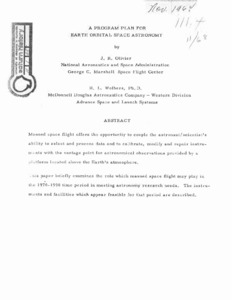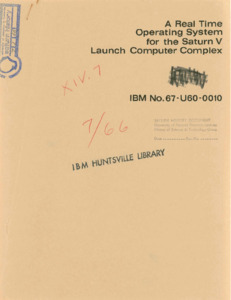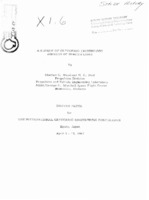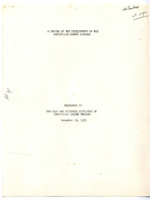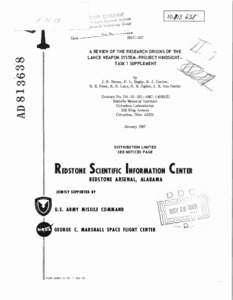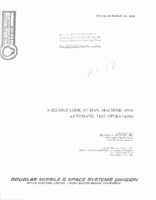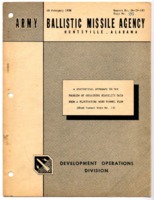
Browse Items (6630 total)
Sort by:
-
"A Program plan for earth orbital space astronomy."
Manned space flight offers the opportunity to couple the astronaut/scientist's ability to select and process data and to calibrate, modify and repair instruments with the vantage point for astronomical observations provided by a platform located above the Earth's atmosphere. This paper briefly examines the role which manned space flight may play in the 1970-1990 time period in meeting astronomy research needs. The instruments and facilities which appear feasible for that period are described.; Paper presented by J. R. Olivier, National Aeronautics and Space Administration, George C. Marshall Space Flight Center and H. L. Wolbers, Ph.D, McDonnell Douglas Astronautics Company - Western Division, Advance Space and Launch Systems. -
"A Promotion...A Party...A Pity"
Woman's purse and shoe on street outside of a bar as a cab drives away -
"A real time operating system for the Saturn V launch computer system."
Presentation aimed to encourage a final check on the Saturn V project before its first launch to ensure safety and success. -
"A Review of Cryogenic Technology Aspects of Space Flight."
This paper was presented at the International Cryogenic Engineering Conference in Kyoto, Japan. It details the use of cryogenic technology in rocketry and how its usage created "many new techniques and deeply stimulated many fields of cryogenic technology." -
"A Review of the Development of the Huntsville Campus Library."
Prepared by Librarian Christel L. McCanless and presented to the Arts and Sciences Committee on Huntsville Degree Program. The document includes a review of library materials and an outline of future plans, including comparisons to collections at other universities. -
"A review of the research origins of the LANCE weapon system -- Project hindsight -- Task 1 supplement."
This report includes a discussion of 57 research and exploratory development events that have been identified as contributing significantly to LANCE. Forty-six of these are research events. Eight of the research events deal with LANCE aerodynamics, four with propulsion, 24 with solid-state components used in the guidance and control system,and 10 with the research origins of the materials and manufacturing processes used in LANCE. In addition, 11 exploratory development events are identified. The principal concern of this study has been the identification of further research origins of LANCE and the 46 documented events are its major product. A further concern and obligation of this study has been to provide HINDSIGHT with some additional data on the research phenomenon including some further observations on the nature and route of research utilization.; FOREWORD: The purpose of this report is to present a survey of fundamental research contributing to the successful development of the LANCE weapon system. Included in this report are discussions of research inputs to a number of LANCE systems and technology areas. The circumstances of these research contributions to LANCE are discussed. The implications of these examples of research utilization are analyzed and some general observations and conclusions on the research payoff phenomena are given. This report was requested by the Army Missile Command as a supplemental contribution to Project HINDSIGHT.; Contract No. DA-01-021-AMC-14693(Z).; Battle Memorial Institute ,Columbus Laboratories.; RSIC-627.; Includes letter from W. Metscher, Lt. Col. to Mr. David L. Christensen dated March 14, 1969. -
"A round of well-placed shots will stop this killer!; Anthrax Bacterium "
Shots and picture of anthrax bacterium under a microscope -
"A Second Look at Man, Machine, and Automatic Test Operations."
A summary found following the errata page reads: "This paper presents a second look at the subject of the man-machine relationship in automatic test operations. 'Man, Machine, and Automatic Test Operations' was presented by the writer at Battelle Memorial Institute in November of 1963...It is the purpose of this second look at the man-machine interface to pinpoint those concepts which have proven their worth with time and those concepts which have proven to be weak, and as a result modified with time." This paper was prepared by George F. Meister, Jr. -
"A Stitch in Time...hotline for fraud, waste, abuse reporting"
coin purse with a hole in it dropping coins and needle and thread
